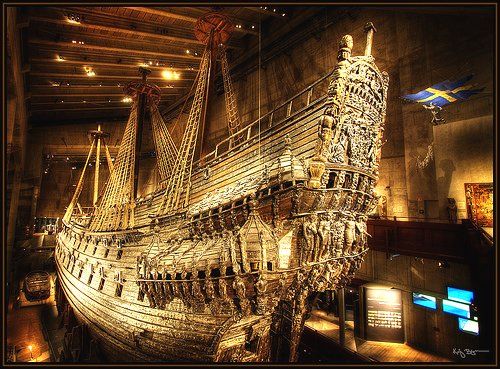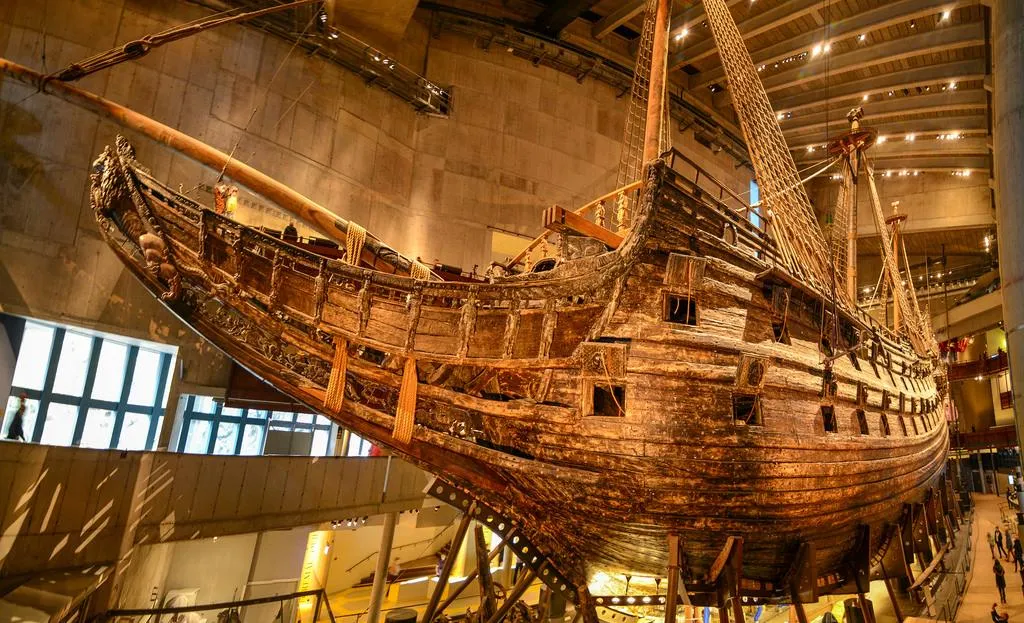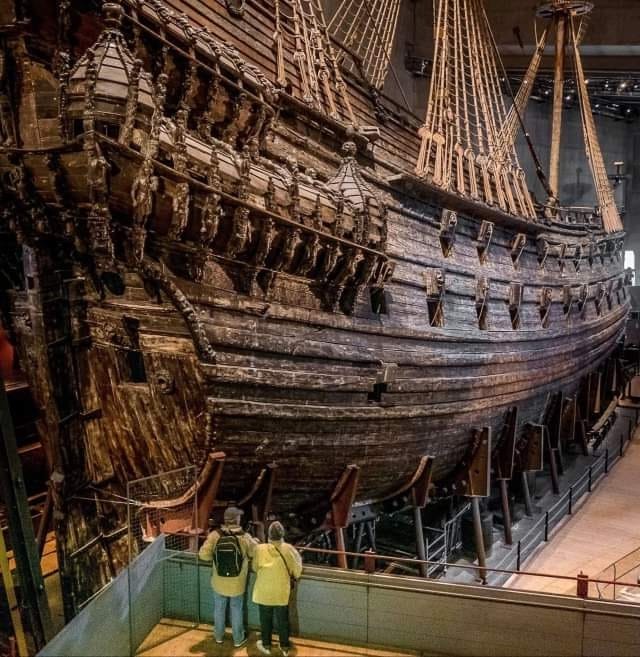A Fateful Voyage: The Demise and Redemption of the Vasa
Imprinted in the annals of maritime history, the tale of the Vasa continues to mesmerize with its blend of fascination and intrigue. This Swedish warship, destined for glory, met a premature and tragic end during its inaugural journey in 1628. However, the Vasa’s story refused to fade into oblivion, as an extraordinary archaeological discovery breathed new life into its legend. Today, the Vasa stands proudly in Stockholm’s Vasamuseet, a testament to both the triumphs and calamities that shaped naval engineering in the 17th century.
Commissioned by King Gustavus Adolphus of Sweden, the Vasa was a majestic vessel designed to showcase the nation’s naval supremacy and project its military might. Alas, its aspirations were dashed in a cruel twist of fate mere moments after setting sail. Merely a mile from the harbor, the mighty warship succumbed to a catastrophic capsize, sinking into the depths of the sea. The calamity that befell the Vasa was attributed to a convergence of design deficiencies, including inadequate stability and an excessive placement of heavy cannons on the upper decks. The tragic demise of the Vasa left an indelible imprint on Swedish history, provoking contemplation of the builders’ hubris and the perils of unbridled ambition.
Yet, the Vasa’s story took an unexpected turn. Centuries later, in a remarkable feat of marine archaeology, the ship was salvaged from its watery resting place. Slowly and painstakingly, the remains of the Vasa were meticulously recovered, preserving not just a sunken warship but a tangible link to the past. The vessel’s resurrection offered invaluable insights into the craftsmanship, technology, and societal values of the 17th century.

Today, housed within the magnificent Vasamuseet, the Vasa is a symbol of resilience and redemption. Its meticulously restored form stands as a captivating time capsule, inviting visitors to marvel at the intricate details of a bygone era. The Vasa serves as a poignant reminder of the complexities inherent in naval engineering, the fragility of human aspirations, and the power of historical artifacts to transcend time and captivate the imagination.
The Vasa’s legacy encompasses more than just a tragic voyage; it is a testament to human ingenuity, the pursuit of knowledge, and the enduring spirit of exploration. As visitors gaze upon its grandeur, they are transported back to a pivotal moment in history, where triumph and tragedy converged upon the restless seas.
Resurrecting the Vasa: A Triumph of Salvage and Restoration
For centuries, the Vasa, once a proud symbol of Swedish naval power, lay obscured and forgotten beneath the murky depths of Stockholm’s harbor. However, in a momentous turn of events in 1961, the ship’s sunken remains were rediscovered by Swedish archaeologists, shrouded in layers of sediment and preserved by the unique properties of the Baltic Sea. What followed was an awe-inspiring endeavor to rescue the Vasa from its watery tomb—a monumental feat that would redefine the boundaries of maritime archaeology.
The arduous task of recovering the Vasa demanded unwavering dedication and ingenuity. A team of experts meticulously planned and executed a complex salvage operation, pushing the boundaries of engineering and technology. Innovative methods were employed, combining hydraulic jacks, pontoons, and careful diversions of water flow to raise the immense vessel from its aquatic resting place. Years of meticulous work unfolded as the ship was painstakingly hoisted and supported, ensuring its fragile structure remained intact.

The emergence of the Vasa from the depths was nothing short of miraculous. Despite spending centuries beneath the waves, the ship surfaced with an astonishing level of preservation, offering a remarkable glimpse into the past. The intricate carvings, ornate decorations, and intricately painted details that adorned the vessel spoke volumes about the craftsmanship and artistry of the 17th century.
The recovery of the Vasa not only captivated the imagination of the world but also sparked a profound resurgence of interest in maritime archaeology. The ship’s resurrection became a turning point, expanding our understanding of historical preservation and the possibilities of extracting knowledge from the depths of the sea. The Vasa’s remarkable recovery demonstrated the tenacity of humanity in unearthing and preserving our collective heritage.
Today, the Vasa stands proudly in its meticulously reconstructed form, housed within the awe-inspiring Vasamuseet. The museum serves as a testament to the unwavering commitment to preserving the ship and sharing its captivating story with the world. Visitors from all walks of life can now witness the grandeur of the Vasa, marvel at its intricate details, and immerse themselves in the rich history that it represents.
The rise of the Vasa from its watery grave has not only enriched our knowledge of naval architecture and craftsmanship but has also ignited a deeper appreciation for the untold stories that lie beneath the ocean’s surface. It serves as a poignant reminder of the resilience of the human spirit, the power of discovery, and the enduring allure of uncovering the mysteries of our past.
Unveiling the Maritime Time Capsule: Rediscovering the Vasa’s Secrets
The Vasa, with its remarkable journey from the depths of the Baltic Sea to the halls of the Vasamuseet, stands as a living testament to the ingenuity and craftsmanship of 17th-century shipbuilders. This enduring icon of Sweden’s maritime heritage offers a captivating glimpse into a bygone era, immersing visitors in a world where triumph and tragedy converged upon the restless seas. Through meticulous conservation and archaeological efforts, the Vasa’s legacy has been preserved, ensuring that its story continues to inspire and educate future generations.
The recovery and restoration of the Vasa represent a triumph of archaeological exploration and preservation. With every careful excavation and meticulous analysis, archaeologists have unveiled the ship’s secrets, piece by piece. From the intricately carved decorations to the preserved artifacts found onboard, each discovery provides invaluable insights into the lives of sailors, the artistry of the time, and the technological advancements of naval engineering.
The role of archaeology in unraveling the mysteries of the Vasa cannot be overstated. It is through the dedicated work of archaeologists, conservators, and researchers that the ship’s story has been meticulously reconstructed. By delving into the depths, exploring the wreckage, and meticulously piecing together the fragments of history, archaeologists have breathed life into the Vasa’s past, illuminating both its triumphs and its tragic demise.

Unveiling the Depths: The Role of Archaeology
As we continue to explore the depths of our oceans and unearth the remnants of our maritime history, the Vasa serves as a beacon, highlighting the importance of archaeological endeavors. It reminds us of the power of archaeology to bridge the gap between the past and the present, enabling us to better understand the world we inhabit today. The Vasa’s preservation is a testament to our shared commitment to safeguarding our cultural heritage and ensuring that the lessons and stories of the past resonate with future generations.
Through the Vasa, we are reminded that history is not confined to the pages of a book; it resides in the artifacts and structures that have withstood the test of time. It is in the careful preservation and exploration of these treasures that we gain a deeper understanding of our collective human experience. The Vasa stands as a symbol of our dedication to preserving history, ensuring that its legacy endures as a source of knowledge, inspiration, and wonder for generations to come.